Table of Contents
Introduction
A Look At Personal Narratives
Personal narratives have been at the center of many writing forms, whether it is an essay, short story, or even a novel. They describe a specific incident or event in the life of a writer and how it changed the courses of thought and action.
The incident does not have to be exotic or thrilling necessarily to make the narrative interesting. Anything from introspection after an accident to describing the details of that accident can become a narrative.
Personal narratives are widely used to connect with people at an emotional level. Even though the experiences are personal, they should be penned down with a solid theme and purpose to ensure that readers get to understand and relate to them.
Structures to Follow
Every life is lived in different circumstances so the events and experiences are novel for everyone else. Still, academics have identified recurring themes and elements that are found in great narrative essays.
Introduction/ Opening: In literature, writers spend a lot of time composing opening lines and paragraphs to grab readers’ attention. In narrative essays, students must open with a hook to get readers invested in the story.
Plot: The sequence of events that happen in a story is called a plot. It needs to be logical and believable for the readers, not to mention it should be clear that readers can connect the dots with the bare minimum of information.
Characters: The people in a story, including the writer, makes up for the characters. They can be supporting and sporadic or play a dominant role in how the story would turn out.
Setting: Setting deals with the when, where, how, why, and what of the story. Again, it should be vivid and logical to make sense of the events.
Climax: This can be the highest point of conflict, change, or tension in the narrative. Make sure the rest of the story builds up to it before moving on to the resolution.
Conclusion: Conclusions cover the lessons and insights that can be drawn from the narratives. They should be enticing and make sense of the things that happened in the story.
A Traditional Personal Narrative Template
A traditional template for a narrative essay has three distinct sections:
- Introduction
The introduction or opening of the personal narrative places the hook and set the scene. It also makes it clear what the essay will be about with a strong and bold thesis statement.
- Body
The body does the heavy lifting as it is the bones and meat of the essay. It describes the events with supporting evidence and characters to make sure the scenes become clear and easy to follow. It also deals with the transition to and from the “big event”.
- Conclusion
In simple words, the conclusion offers moral lessons and other parallels that can be drawn for the narrative that readers can understand and relate to.
Parameters For Composing Essays
Turning Personal Narrative Into A Story
There is speculation among students about turning a personal narrative into a story. The truth is a personal narrative essay is a story based on a personal experience or incident. It is just like any other story with a distinct beginning, body with characters and settings, and a conclusion.
Also, the story should be personal but relatable with vivid details and a plot that is easy to follow by the readers. Depending on the actual topic, you can introduce the elements of humor, suspense, thrill, and others to your story.
Giving Clear Purpose To Your Writing
On the surface, the purpose of writing a narrative essay or a story can be simple, to tell a story. But if you dig a little deeper, there is much more to it. Writing a narrative means telling a story with meaning and depth to the readers. They can deduce lessons and insights from the story and even apply that to incidents and experiences they might have had in their lives.
Relating Narrative To The Right Person
There are more than the narrator in these essays. Both secondary characters and plot points play a great tool to complete the story. Still, they should not dominate the protagonist, which is the writer.
Since it is a story based on personal experience, the underlying after-shocks should affect the person at all levels.
Playing With Essay Topics & Ideas
Nailing The Theme
By theme, we mean the central meaning of the whole narrative. The theme goes through what the characters say and what they go through. It is also represented by the plot and setting of the story and the ideas and insight that can be drawn from it.
The most common themes in personal narratives are tragedy, loss, redemption, and many more. In all cases, even when the writer does not have a clear theme in mind and is just describing a moving event, a solid theme can be built around it and readers can draw parallels.
Picking The Right Trigger of Events
A story could become bland if it does not have enough structure and tension. That’s why writers have to build up the tension and state the chain of events right before it triggers the change.
For instance, if the narrative is about a loved one’s death, it should describe why that person was important to the writer and how the death affected later life. Otherwise, it would all be moot and seemed like an ordinary day in somebody’s life.
Best Examples Of Personal Narratives
It is hard to come up with the best examples for personal narratives because they are personal and some things resonate more with one kind of person than the other. Still, the topics of loss, rage, redemption, and tragedy are considered to be the themes to explore in your narrative.
You can find many essays written by brilliant authors that take the narrative element to new heights with their scene-setting and storytelling.
Commencing The Writing Part
Narrative essays are never supposed to be boring. What makes a narrative boring is the dry setting and life-less, two-dimensional characters. So, setting the perfect scene is important to bring life to the whole text. The best way to do this is by dropping the reader right into the action and using imagery to evoke scenes in their minds. Readers, while planted in a story are prone to sensory effects. That’s why writers need to set up things right from the start.
Even in a long story or a novel, there is always a central point of change, a conflict, that can set change the course of action for the rest of the story. In a short narrative essay for a school or a college, it is necessary to have a central point of focus. Writers should build tension around it and then execute it to make sure that the themes and purpose of the narrative are made abundantly clear.
Personal narratives are emotional as they revolve around a personal event or experience. But simply describing the event is not enough. There are many ways students can put emotions into their words. The most common method is by showing and not telling what went down. Additionally, setting the narrative in such a way as though readers feel themselves in the middle of the scenes can be a great booster.
Tying The Ends For The Ending
Ensuring All The Essentials Are Covered
If novice writers think that opening a superb narrative essay is hard, they should try closing one. Since it will be the last thing that readers will go through in your essay, it should be remarkable in every aspect.
Experts suggest that it will be reflective and should highlight the theme and underlying moral lessons from the incident, along with the purpose of writing. Still, there is no need to get carried away and spill all the beans. Some elements can be left undone for the readers to figure out.
Going Through It Multiple Times
Simply getting the first draft down is not the end of writing, but just the beginning. No matter how much care and attention you have put into the narrative, there will be errors and inconsistencies in it.
That’s why it is necessary to go through the text multiple times and make sure that it has no grammatical or contextual issues. If you are writing one for college or school, it should be reviewed and edited vigorously before turning it in.
Sharing The Finished Copy With Others
Others can be a great critique of your work. So, there is no harm in getting other people in the circle and giving them your finished work for a read. They can look at it with a fresh perspective and can help you get many irregularities straightened out.
Both friends and family can be of great help in this regard.
F.A.Q
What are the 5 crucial components of a personal narrative?
A personal narrative is often composed of at least 5 parts and can be more than their sum if the execution is right. Writers must keep these parts in mind and make sure to give each one the same thought and attention to weave a convincing story.
- Opening
- Plot
- Characters & Setting
- Climax
- Closing
What makes a good personal narrative?
The reason behind writing one is what makes it good. Based on a personal incident or an experience, it needs to tell the readers what happened and what were the effects of that incident. Certainly, it is not a bland report about what went down, but a vivid description of a life-altering experience.
A narrative is good when it is easily understood and relatable to readers.
What is an example of a personal narrative?
Any incident or experience from a past can be an example of a narrative, even if you can only recall it in your mind and draw a picture to reflect themes and lessons. Mostly, it is about a trip or visiting a person or coming of a person. In other cases, it can be about death and tragedy.
Personal narratives follow a certain theme and should fall in line with the popular lines drawn by the experts.
How many paragraphs is a personal narrative essay?
At the school level, a personal narrative essay has usually five paragraphs. They each perform a specific duty and offer a special purpose.
- Introduction 1 paragraph, (setting the scene, presenting a hook, thesis statement)
- Body 3 paragraph, (description of events, characters, the unfolding of the plot)
- Conclusion 1 paragraph (summing up the narrative, moral lessons, and reflections)
What makes a good introduction to a personal narrative?
Following are some of the essentials to make a good introduction:
- The opening lines of the paragraph should have a capable hook to lure the readers in
- It should set the scene so that readers can become invested in what is about to come
- The thesis statement should be clear, concise, and bold
Concluding Remarks
Writing a narrative essay requires practice and patience. It also requires recalling old memories and incidents that shaped the present and foreseeable future for the writer. In this post, we have summed up things from getting started, how to write a personal narrative essay, and how to tie the ends for the conclusion.
After going through it, students can draw many valuable lessons and apply them in their writing in the future, whether for a school narrative essay or college admission. They are most popular at college because they offer deeper introspection and reveal writing and researching chops. Before writing your next essay, it is best to go through this guide for assistance.




